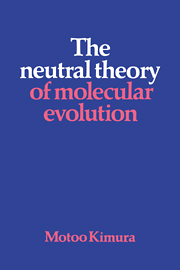Book contents
- Frontmatter
- Contents
- Preface
- Introduction
- 1 From Lamarck to population genetics
- 2 Overdevelopment of the synthetic theory and the proposal of the neutral theory
- 3 The neutral mutation-random drift hypothesis as an evolutionary paradigm
- 4 Molecular evolutionary rates contrasted with phenotypic evolutionary rates
- 5 Some features of molecular evolution
- 6 Definition, types and action of natural selection
- 7 Molecular structure, selective constraint and the rate of evolution
- 8 Population genetics at the molecular level
- 9 Maintenance of genetic variability at the molecular level
- 10 Summary and conclusion
- References
- Author Index
- Subject Index
10 - Summary and conclusion
Published online by Cambridge University Press: 05 August 2012
- Frontmatter
- Contents
- Preface
- Introduction
- 1 From Lamarck to population genetics
- 2 Overdevelopment of the synthetic theory and the proposal of the neutral theory
- 3 The neutral mutation-random drift hypothesis as an evolutionary paradigm
- 4 Molecular evolutionary rates contrasted with phenotypic evolutionary rates
- 5 Some features of molecular evolution
- 6 Definition, types and action of natural selection
- 7 Molecular structure, selective constraint and the rate of evolution
- 8 Population genetics at the molecular level
- 9 Maintenance of genetic variability at the molecular level
- 10 Summary and conclusion
- References
- Author Index
- Subject Index
Summary
Traditionally, studies of evolution were concerned only with the visible structures of organisms, such as birds' wings, giraffes' necks, horses' teeth and the like, and their function. The guiding principle by which evolutionary changes in such phenotypes were interpreted was Darwin's theory of natural selection, or the survival of the fittest. In Darwin's time, the mechanism of inheritance and the nature of heritable variations were unknown and this caused Darwin difficulty, but with his great insight he was able to grasp the real significance of natural selection in evolution.
With the rise of Mendelian genetics, the difficulty which troubled Darwin was gradually resolved, and with the development of population genetics, the synthesis of Darwinism and Mendelism was achieved. This led to the ‘synthetic theory’ of evolution which flourished and grew into an impressive edifice toward the end of 1950s. Although various factors such as mutation, recombination, and migration were taken into account, the dominating feature of the ‘synthetic theory’ was, and still is, its great emphasis on natural selection. It claimed that the speed and direction of evolution are predominantly determined by positive selection with mutation playing only a subsidiary role. Because of this character, it has also been called the neo-Darwinian theory.
- Type
- Chapter
- Information
- The Neutral Theory of Molecular Evolution , pp. 305 - 327Publisher: Cambridge University PressPrint publication year: 1983
- 2
- Cited by

